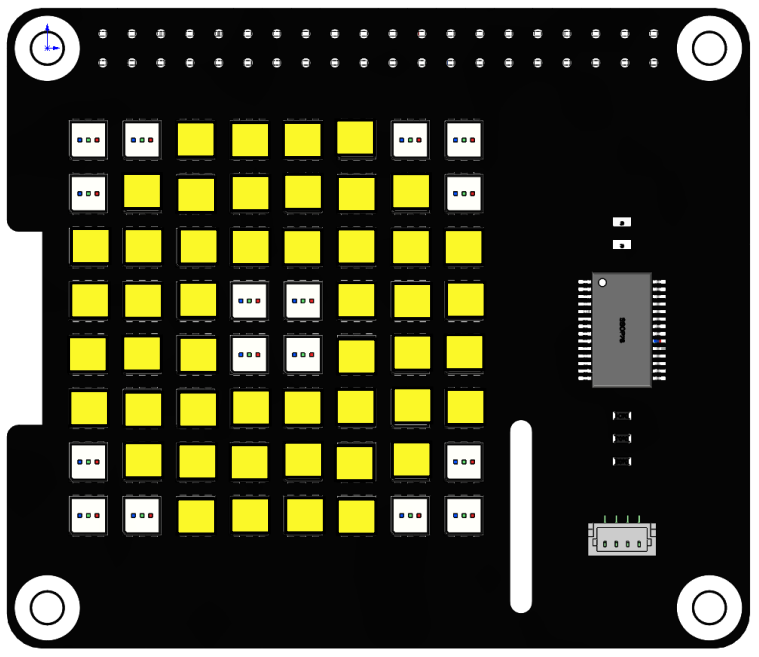Moving Eye¶
In this project, we will use the draw_rectangle() and draw_point() functions to draw an eye pattern and achieve the effect of moving the eye around.

Run the code
When the program is running, you will see an eye moving around on the RGB matrix HAT.
cd /home/pi/rgb_matrix/raspberrypi
sudo python3 moving_eyes.py
Code
Note
You can Modify/Reset/Copy/Run/Stop the code below. But before that, you need to go to source code path like rgb_matrix/raspberrypi. After modifying the code, you can run it directly to see the effect.
from rgb_matrix import RGB_Matrix
import time
def up(list,step=1):
for i in range(0,step):
rr.draw_rectangle(list,fill=(251,248,40))
list[1] -= 1
list[3] -= 1
rr.draw_rectangle(list,fill=(0,0,0))
rr.display()
def down(list,step=1):
for i in range(0,step):
rr.draw_rectangle(list,fill=(251,248,40))
list[1] += 1
list[3] += 1
rr.draw_rectangle(list,fill=(0,0,0))
rr.display()
def left(list,step=1):
for i in range(0,step):
rr.draw_rectangle(list,fill=(251,248,40))
list[0] -= 1
list[2] -= 1
rr.draw_rectangle(list,fill=(0,0,0))
rr.display()
def right(list,step=1):
for i in range(0,step):
rr.draw_rectangle(list,fill=(251,248,40))
list[0] += 1
list[2] += 1
rr.draw_rectangle(list,fill=(0,0,0))
rr.display()
def left_down(list,step=1):
for i in range(0,step):
rr.draw_rectangle(list,fill=(251,248,40))
list[0] -= 1
list[2] -= 1
list[1] += 1
list[3] += 1
rr.draw_rectangle(list,fill=(0,0,0))
rr.display()
def left_up(list,step=1):
for i in range(0,step):
rr.draw_rectangle(list,fill=(251,248,40))
list[0] -= 1
list[2] -= 1
list[1] -= 1
list[3] -= 1
rr.draw_rectangle(list,fill=(0,0,0))
rr.display()
def right_up(list,step=1):
for i in range(0,step):
rr.draw_rectangle(list,fill=(251,248,40))
list[0] += 1
list[2] += 1
list[1] -= 1
list[3] -= 1
rr.draw_rectangle(list,fill=(0,0,0))
rr.display()
def right_down(list,step=1):
for i in range(0,step):
rr.draw_rectangle(list,fill=(251,248,40))
list[0] += 1
list[2] += 1
list[1] += 1
list[3] += 1
rr.draw_rectangle(list,fill=(0,0,0))
rr.display()
if __name__ == "__main__":
rr = RGB_Matrix(0X74)
rectangle_coor = [0,0,7,7]
rr.draw_rectangle(rectangle_coor,fill=(251,248,40))
point_arry = [[0,0],[1,0],[0,1],[6,0],[7,0],[7,1],[0,6],[0,7],[1,7],[7,6],[7,7],[6,7]]
for i in range(len(point_arry)):
rr.draw_point(point_arry[i],fill=(0,0,0))
list = [3,3,4,4]
rr.draw_rectangle(list,fill=(0,0,0),outline=None, width=0)
rr.display()
while True:
up(list,3)
down(list,6)
up(list,6)
down(list,6)
up(list,3)
time.sleep(1)
right_down(list,2)
up(list,4)
left(list,4)
down(list,4)
right(list,4)
left_up(list,2)
time.sleep(1)
How it works?
rectangle_coor = [0,0,7,7]
rr.draw_rectangle(rectangle_coor,fill=(251,248,40))
point_arry = [[0,0],[1,0],[0,1],[6,0],[7,0],[7,1],[0,6],[0,7],[1,7],[7,6],[7,7],[6,7]]
for i in range(len(point_arry)):
rr.draw_point(point_arry[i],fill=(0,0,0))
list = [3,3,4,4]
rr.draw_rectangle(list,fill=(0,0,0),outline=None, width=0)
rr.display()
The list
rectangle_coorrepresents a rectangle (the whole RGB dot matrix) from coordinates (0, 0) to (7, 7), and then use thedraw_rectangle()function to fill this rectangle with yellow.The list
point_arryrepresents the 12 points in the four corners, then use thedraw_point()function to set the color of each point to (0, 0, 0), i.e., extinguish these points. This depicts the outline of an eye.The
listrepresents a small rectangle from (3, 3) to (4, 4), and then use thedraw_rectangle()function to set the color of this rectangle to (0, 0, 0) to make the rectangle go out. This will describe the outline of the eyeball.Finally, the eye pattern is displayed on the RGB Matrix HAT using the
display()function.
while True:
up(list,3)
down(list,6)
up(list,6)
down(list,6)
up(list,3)
time.sleep(1)
right_down(list,2)
up(list,4)
left(list,4)
down(list,4)
right(list,4)
left_up(list,2)
time.sleep(1)
The main loop is to make the eyeball keep moving up and down, then turn one cycle, and finally return to the original position.
We call some functions to move the eyeball, for example up(list,3) is to move the eyeball up three squares, now look at how this function is implemented.
def up(list,step=1):
for i in range(0,step):
rr.draw_rectangle(list,fill=(251,248,40))
list[1] -= 1
list[3] -= 1
rr.draw_rectangle(list,fill=(0,0,0))
rr.display()
The up() function has 2 parameters list and step, the internal logic is to move the rectangle list up step squares (default is 1).
Define a
for()loop with the number of loops determined bystep. In thefor()loop, set the color of the rectanglelistto yellow.list = [3,3,4,4]are the 2 diagonal coordinates (3,3) and (4,4),list[1]andlist[3]are subtracted by one, meaning that the y-values of the 2 diagonal coordinates are subtracted by one.Then the modified
list = [3,2,4,3]color is set to (0,0,0) by the functiondraw_rectangle()and displayed on the dot matrix by the functiondisplay().After one for loop in this way, the pupil is moved up one square.